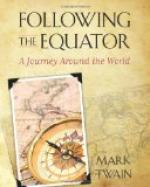Total,.......................320,431
The item in the above list “Other religions” includes the following as returned:
Agnostics,
Atheists,
Believers in Christ,
Buddhists,
Calvinists,
Christadelphians,
Christians,
Christ’s Chapel,
Christian Israelites,
Christian Socialists,
Church of God,
Cosmopolitans,
Deists,
Evangelists,
Exclusive Brethren,
Free Church,
Free Methodists,
Freethinkers,
Followers of Christ,
Gospel Meetings,
Greek Church,
Infidels,
Maronites,
Memnonists,
Moravians,
Mormons,
Naturalists,
Orthodox,
Others (indefinite),
Pagans,
Pantheists,
Plymouth Brethren,
Rationalists,
Reformers,
Secularists,
Seventh-day Adventists,
Shaker,
Shintoists,
Spiritualists,
Theosophists,
Town (City) Mission,
Welsh Church,
Huguenot,
Hussite,
Zoroastrians,
Zwinglian,
About 64 roads to the other world. You see how healthy the religious atmosphere is. Anything can live in it. Agnostics, Atheists, Freethinkers, Infidels, Mormons, Pagans, Indefinites they are all there. And all the big sects of the world can do more than merely live in it: they can spread, flourish, prosper. All except the Spiritualists and the Theosophists. That is the most curious feature of this curious table. What is the matter with the specter? Why do they puff him away? He is a welcome toy everywhere else in the world.
CHAPTER XIX.
Pity is for the living, Envy is for the dead.
—Pudd’nhead
Wilson’s New Calendar.
The successor of the sheet-iron hamlet of the mangrove marshes has that other Australian specialty, the Botanical Gardens. We cannot have these paradises. The best we could do would be to cover a vast acreage under glass and apply steam heat. But it would be inadequate, the lacks would still be so great: the confined sense, the sense of suffocation, the atmospheric dimness, the sweaty heat—these would all be there, in place of the Australian openness to the sky, the sunshine and the breeze. Whatever will grow under glass with us will flourish rampantly out of doors in Australia.—[The greatest heat in Victoria, that there is an authoritative record of, was at Sandhurst, in January, 1862. The thermometer then registered 117 degrees in the shade. In January, 1880, the heat at Adelaide, South Australia, was 172 degrees in the sun.]
When the white man came the continent was nearly as poor, in variety of vegetation, as the desert of Sahara; now it has everything that grows on the earth. In fact, not Australia only, but all Australasia has levied tribute upon the flora of the rest of the world; and wherever one goes the results appear, in gardens private and public, in the woodsy walls of the highways, and in even the forests. If you see a curious or beautiful tree or bush or flower, and ask about it, the people, answering, usually name a foreign country as the place of its origin—India, Africa, Japan, China, England, America, Java, Sumatra, New Guinea, Polynesia, and so on.




